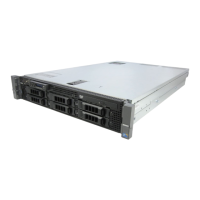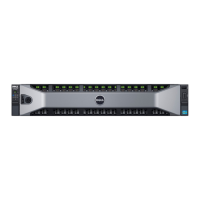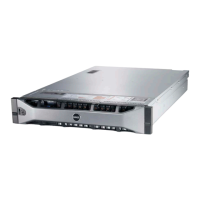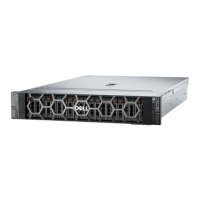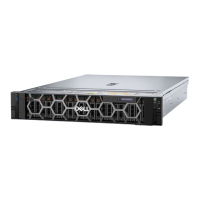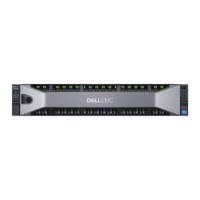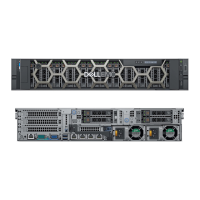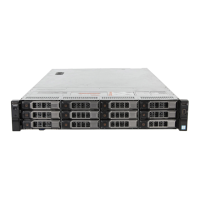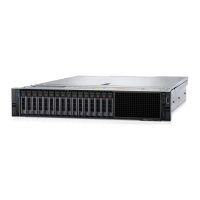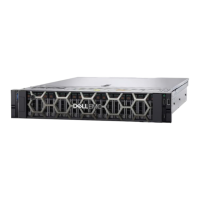Do you have a question about the Dell POWEREDGE R710 and is the answer not in the manual?
Learn how to access system features during startup using specific keystrokes.
Details the features and indicators located on the front panel of the system.
Describes the system's LCD panel, its backlight, and button functions.
Explains the meaning of drive-status indicator patterns for RAID configurations.
Identifies and describes the features and indicators on the system's back panel.
Explains the status indicated by the LED on the power button and power supplies.
Details the meaning of link and activity indicators for the Network Interface Controller.
Lists and explains the brief text messages displayed on the LCD for system events.
Provides information on system messages that notify of potential problems.
Alerts to potential problems, prompting user response before task continuation.
Messages issued by system diagnostic utilities during tests.
Generated by systems management software for system status and failures.
Lists additional resources and documentation for system information.
Explains how to select the boot mode (BIOS or UEFI) for installing the operating system.
Provides steps to access the system setup program using keystrokes during POST.
Details the various configuration options available in the main system setup screen.
Configures system memory size, type, speed, testing, and operating mode.
Configures processor-specific options like speed, cores, and virtualization.
Enables or disables the integrated SATA controller and ports.
Specifies boot mode, boot sequence, and emulation types for bootable media.
Enables or disables integrated system devices like storage controllers and NICs.
Allows manual selection of IRQ for PCIe devices.
Configures serial communication devices and redirection options.
Configures front-panel LCD options and user-defined strings.
Manages system power usage for processors, fans, and memory.
Configures system passwords, TPM security, and power button behavior.
Options for saving changes, discarding them, or returning to setup.
Instructions to access and use the UEFI Boot Manager for boot option management.
Details on assigning and managing system and setup passwords for security.
Accesses the pre-boot environment for iDRAC6 configuration.
Lists essential tools required for system component installation and servicing.
Provides an overview of the system's internal layout and components.
Instructions for removing and installing the optional front bezel.
Details the slide-out label panel for system information.
Step-by-step guide on how to open and close the system chassis.
Information on installing, removing, and configuring hard drives.
Details on removing, replacing, and installing system power supply units.
Instructions for installing and removing the internal SD module.
Procedures for installing and removing an internal SD flash card.
Information on using an internal USB memory key as a boot device.
Guides for removing and installing the internal USB cable.
Steps for installing and removing the optional iDRAC6 Enterprise card.
Instructions for inserting and removing the VFlash media (SD card).
Details on installing the optional NIC hardware key for enhanced functionality.
Instructions for removing and installing the system's cooling shroud.
Procedures for removing, replacing, and installing system cooling fans.
Steps for removing and installing the optional optical drive.
Essential safety precautions for system servicing and user protection.
Steps to diagnose and resolve issues preventing the system from starting up.
Guidance on verifying and troubleshooting external cable connections.
Steps to diagnose and resolve problems with the system's video output.
Methodology for troubleshooting issues with USB devices like keyboards and mice.
Procedure for diagnosing and resolving problems with serial I/O devices.
Steps to diagnose and resolve issues related to the Network Interface Controller.
Procedure for handling and troubleshooting systems exposed to moisture.
Steps to ensure components are properly installed after system damage.
Guidance on resolving issues related to the system's battery and time/date settings.
Steps to identify and resolve issues with the system's power supply units.
Checks for conditions that may cause system overheating or improper cooling.
Procedure for diagnosing and resolving issues with system cooling fans.
Steps to diagnose and resolve problems related to system memory modules.
Procedure for diagnosing and resolving issues with the internal SD card.
Steps to diagnose and resolve problems with the internal USB memory key.
Procedure for diagnosing and resolving issues with the optical drive.
Steps to diagnose and resolve problems with the tape backup unit.
Procedure for diagnosing and resolving issues with system hard drives, including RAID.
Steps to diagnose and resolve issues with SAS or PERC storage controllers.
Procedure for diagnosing and resolving issues with installed expansion cards.
Steps to diagnose and resolve issues related to the system's processor(s).
Guide to using Dell's online diagnostics for system assessment.
Overview of the features and options provided by the system diagnostics.
Criteria for determining when to run system diagnostics for problem identification.
Instructions on how to launch and operate the system diagnostics program.
Descriptions of available testing options like Express, Extended, and Custom tests.
Details on selecting devices and specific options for custom diagnostic tests.
How to choose specific devices or components for diagnostic testing.
Options for configuring diagnostic tests, such as test iterations and failure handling.
Explains how to access and interpret test results, errors, and configuration data.
Information on system board jumpers for configuration and password management.
Diagrams and descriptions of connectors on the system board.
Details of connectors found on the SAS backplane board.
Overview of expansion card riser components and PCIe bus interfaces.
Procedure to clear system or setup passwords using a jumper.
Information on how to contact Dell support for assistance.
Learn how to access system features during startup using specific keystrokes.
Details the features and indicators located on the front panel of the system.
Describes the system's LCD panel, its backlight, and button functions.
Explains the meaning of drive-status indicator patterns for RAID configurations.
Identifies and describes the features and indicators on the system's back panel.
Explains the status indicated by the LED on the power button and power supplies.
Details the meaning of link and activity indicators for the Network Interface Controller.
Lists and explains the brief text messages displayed on the LCD for system events.
Provides information on system messages that notify of potential problems.
Alerts to potential problems, prompting user response before task continuation.
Messages issued by system diagnostic utilities during tests.
Generated by systems management software for system status and failures.
Lists additional resources and documentation for system information.
Explains how to select the boot mode (BIOS or UEFI) for installing the operating system.
Provides steps to access the system setup program using keystrokes during POST.
Details the various configuration options available in the main system setup screen.
Configures system memory size, type, speed, testing, and operating mode.
Configures processor-specific options like speed, cores, and virtualization.
Enables or disables the integrated SATA controller and ports.
Specifies boot mode, boot sequence, and emulation types for bootable media.
Enables or disables integrated system devices like storage controllers and NICs.
Allows manual selection of IRQ for PCIe devices.
Configures serial communication devices and redirection options.
Configures front-panel LCD options and user-defined strings.
Manages system power usage for processors, fans, and memory.
Configures system passwords, TPM security, and power button behavior.
Options for saving changes, discarding them, or returning to setup.
Instructions to access and use the UEFI Boot Manager for boot option management.
Details on assigning and managing system and setup passwords for security.
Accesses the pre-boot environment for iDRAC6 configuration.
Lists essential tools required for system component installation and servicing.
Provides an overview of the system's internal layout and components.
Instructions for removing and installing the optional front bezel.
Details the slide-out label panel for system information.
Step-by-step guide on how to open and close the system chassis.
Information on installing, removing, and configuring hard drives.
Details on removing, replacing, and installing system power supply units.
Instructions for installing and removing the internal SD module.
Procedures for installing and removing an internal SD flash card.
Information on using an internal USB memory key as a boot device.
Guides for removing and installing the internal USB cable.
Steps for installing and removing the optional iDRAC6 Enterprise card.
Instructions for inserting and removing the VFlash media (SD card).
Details on installing the optional NIC hardware key for enhanced functionality.
Instructions for removing and installing the system's cooling shroud.
Procedures for removing, replacing, and installing system cooling fans.
Steps for removing and installing the optional optical drive.
Essential safety precautions for system servicing and user protection.
Steps to diagnose and resolve issues preventing the system from starting up.
Guidance on verifying and troubleshooting external cable connections.
Steps to diagnose and resolve problems with the system's video output.
Methodology for troubleshooting issues with USB devices like keyboards and mice.
Procedure for diagnosing and resolving problems with serial I/O devices.
Steps to diagnose and resolve issues related to the Network Interface Controller.
Procedure for handling and troubleshooting systems exposed to moisture.
Steps to ensure components are properly installed after system damage.
Guidance on resolving issues related to the system's battery and time/date settings.
Steps to identify and resolve issues with the system's power supply units.
Checks for conditions that may cause system overheating or improper cooling.
Procedure for diagnosing and resolving issues with system cooling fans.
Steps to diagnose and resolve problems related to system memory modules.
Procedure for diagnosing and resolving issues with the internal SD card.
Steps to diagnose and resolve problems with the internal USB memory key.
Procedure for diagnosing and resolving issues with the optical drive.
Steps to diagnose and resolve problems with the tape backup unit.
Procedure for diagnosing and resolving issues with system hard drives, including RAID.
Steps to diagnose and resolve issues with SAS or PERC storage controllers.
Procedure for diagnosing and resolving issues with installed expansion cards.
Steps to diagnose and resolve issues related to the system's processor(s).
Guide to using Dell's online diagnostics for system assessment.
Overview of the features and options provided by the system diagnostics.
Criteria for determining when to run system diagnostics for problem identification.
Instructions on how to launch and operate the system diagnostics program.
Descriptions of available testing options like Express, Extended, and Custom tests.
Details on selecting devices and specific options for custom diagnostic tests.
How to choose specific devices or components for diagnostic testing.
Options for configuring diagnostic tests, such as test iterations and failure handling.
Explains how to access and interpret test results, errors, and configuration data.
Information on system board jumpers for configuration and password management.
Diagrams and descriptions of connectors on the system board.
Details of connectors found on the SAS backplane board.
Overview of expansion card riser components and PCIe bus interfaces.
Procedure to clear system or setup passwords using a jumper.
Information on how to contact Dell support for assistance.
| Tcase | 76 °C |
|---|---|
| Bus type | QPI |
| Stepping | D0 |
| FSB Parity | No |
| Processor code | SLBF7 |
| Processor cache | 8 MB |
| Processor cores | 4 |
| Processor model | E5530 |
| System bus rate | 5.86 GT/s |
| Processor series | Intel Xeon 5500 Series |
| Processor socket | Socket B (LGA 1366) |
| Processor threads | 8 |
| Processor codename | Nehalem EP |
| Motherboard chipset | Intel® 5520 |
| Number of QPI links | 2 |
| Processing Die size | 263 mm² |
| Processor frequency | 2.4 GHz |
| Processor cache type | Smart Cache |
| Processor lithography | 45 nm |
| Processor system type | DP |
| Processor manufacturer | Intel |
| Processor package size | 42.5 x 45 mm |
| Processor front side bus | - MHz |
| Processor boost frequency | 2.66 GHz |
| Processor operating modes | 64-bit |
| ECC supported by processor | Yes |
| Thermal Design Power (TDP) | 80 W |
| Number of processors installed | 1 |
| CPU multiplier (bus/core ratio) | 18 |
| Memory types supported by processor | DDR3-SDRAM |
| Number of Processing Die Transistors | 731 M |
| Memory channels supported by processor | Triple |
| Memory clock speeds supported by processor | 800, 1066 MHz |
| Memory bandwidth supported by processor (max) | 25.6 GB/s |
| Maximum internal memory supported by processor | 144 GB |
| HDD size | 3.5 \ |
| HDD capacity | 146 GB |
| HDD interface | Serial Attached SCSI (SAS) |
| Optical drive type | DVD-ROM |
| Total storage capacity | 292 GB |
| Maximum storage capacity | 6 TB |
| Internal memory | 12 GB |
| Memory clock speed | 1066 MHz |
| Memory layout (slots x size) | 6 x 2 GB |
| Graphics card | G200 |
| Dimensions (WxDxH) | 443.1 x 680.7 x 86.4 mm |
| Non-operating relative humidity (non-condensing) | 5 - 95 % |
| PS/2 ports quantity | 0 |
| USB 2.0 ports quantity | 5 |
| Power supply | 570 W |
| Power requirements | 90 - 264V |
| Compatible operating systems | Windows Server, Standart Business Server, Novell SUSE Linux, Red Hat Linux Enterprise |
| Chassis type | Rack (2U) |
| Storage temperature (T-T) | -40 - 65 °C |
| Operating temperature (T-T) | 10 - 35 °C |
| Operating relative humidity (H-H) | 20 - 80 % |
| Networking features | Gigabit Ethernet |
| Processor ARK ID | 37103 |
| Intel® Turbo Boost Technology | 1.0 |
| Depth | 680.7 mm |
|---|---|
| Width | 443.1 mm |
| Height | 86.4 mm |
| Weight | 26100 g |
